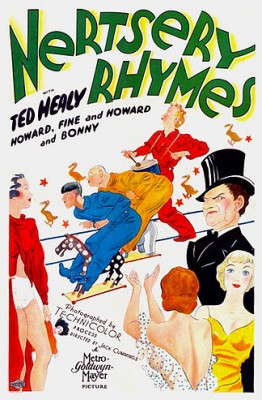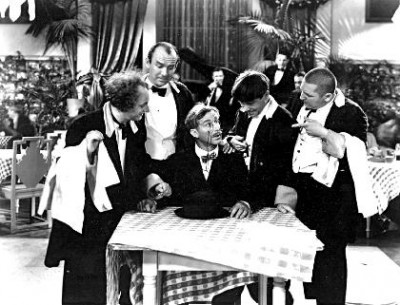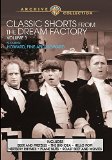| Reviews & Columns |
|
Reviews DVD TV on DVD Blu-ray 4K UHD International DVDs In Theaters Reviews by Studio Video Games Features Collector Series DVDs Easter Egg Database Interviews DVD Talk Radio Feature Articles Columns Anime Talk DVD Savant Horror DVDs The M.O.D. Squad Art House HD Talk Silent DVD
|
DVD Talk Forum |
|
|
| Resources |
|
DVD Price Search Customer Service #'s RCE Info Links |
|
Columns
|
|
|
Classic Shorts from the Dream Factory, Volume 3, Featuring Howard, Fine and Howard (The Three Stooges)
Much less familiar, even to Stooge fans, are the team's pre-Columbian Hollywood years, beginning in 1930. The Vaudeville act that eventually became Ted Healy and His Stooges (at that point featuring Healy, Moe, Larry, and Shemp Howard, Moe and Curly's older brother) joined the mass exodus during the dawn of talking pictures, the foursome debuting in Soup to Nuts, a Fox feature.
Healy, rather than His Stooges, was the main draw in those early days. By the 1920s Healy was among the highest paid acts in Vaudeville, reportedly earning $9,000/week. (Wikipedia claims he was the highest, but I suspect that's incorrect. W.C. Fields, for instance, was I believe better paid, and there may have been others.) He was a wisecracking master-of-ceremonies-type comedian (Milton Berle, for instance, was an acknowledged disciple of his brand of brash comedy), apparently of English or Welsh ancestry. He was bald (he usually wore a hat onstage, and later took to wearing a toupee) and physically towered over his diminutive Stooges, all of Russian- or Lithuanian-Jewish descent).
Today, many find Healy's style of comedy insufferable. But while it's difficult to imagine how such a personality could be so wildly popular, even then, taken into historical-cultural context, Healy could be pretty funny with the right material. (I find him quite hilarious providing comedy relief in MGM's Mad Love, otherwise a deliriously lurid horror-melodrama. He's also good in San Francisco.)
Healy, however, was also a notorious womanizer and an abusive alcoholic, a mean drunk who undervalued the Stooges' contribution to his success. He paid them peanuts compared to the riches he earned slapping them around. The Stooges acrimoniously split with Healy in 1931, performing under various names while battling Healy in the courts. Healy signed "new" Stooges of his own while suing the original Stooges over rights to comedy material they performed after the split. They reteamed late the following year, but Shemp had had his fill of Healy and left the act. Kid brother Jerome replaced him as "Curly" and soon Ted Healy and His Stooges - Howard, Fine and Howard - were signed to the biggest studio in town, Metro-Goldwyn-Mayer.
At MGM, Ted Healy and His Stooges starred in two-reel comedies, appeared to good effect as comedy relief in three feature films (Meet the Baron, Dancing Lady, and Hollywood Party) and, separately, Moe, Larry, and Curly made uncredited bit appearances in other MGM movies. But their stay there was brief, less than two years. Highlights from these appearances were featured in The Lost Stooges (1990), a video documentary hosted by Leonard Maltin that has since been released to DVD, but Classic Shorts from the Dream Factory, Volume 3 is the first time all of the team's MGM-starring shorts have been collected together in one package. Additionally, the set includes Roast-Beef and Movies (1934), featuring Curly with other performers, plus the one Three Stooges short long thought lost forever, Hello Pop! (1933).
These comedies don't much resemble the team's later Columbia two-reelers even though the release dates of their last MGM films and first Columbia ones overlapped, though there is a slight resemblance to their earliest Columbias. They're disjointed and infrequently funny, partly because these shorts unambitiously tend to plunk Ted Healy and His Stooges into material with no particular interest in developing the shorts into a viable, ongoing series. Most, in fact, seem geared to provide bookend-type scenes built around stock footage from earlier MGM flops, mostly two-color Technicolor musicals few cared for when they were new.
Nertsery Rhymes (1933)
The shorts aren't organized chronologically on the DVD but are here, so that the reader might get a better sense of the team's evolution (or lack thereof) at MGM. Their first short casts Moe, Larry, and Curly as the insomniac "children" of Ted Healy, and their scenes are confined entirely to a single set, the children's bedroom. He's trying to slip away for a night out on the town, but they stubbornly insist upon a bedtime story. The "stories" consist largely of footage from two 1930 MGM movies, likewise shot in two-strip Technicolor: Lord Byron of Broadway and the never-quite-finished The March of Time, excerpts of which also turn up in the Stooges' Roast-Beef and Movies (1994) and That's Entertainment! III (1994). At the time those musicals were made the movie-going public had grown weary of the kind of static musical extravaganzas that flooded the market during 1928-29 following the sensation of The Jazz Singer (1927). Nertsery Rhymes may have been seen as a means to get a little mileage out of these expensive musical sequences few saw. Another possible explanation was that the use of expensive two-color Technicolor didn't translate into bigger box office returns, and around this time the Hollywood majors were generally anxious to end their contractual obligations with the Technicolor company and return to less expensive black-and-white. Nertsery Rhymes may have been a means to help fulfill that obligation as inexpensively as possible. The Stooges (including Curly, in his screen debut) certainly look odd, forced as they were to wear the extremely unnatural makeup the process demanded. (** out of *****)
Beer and Pretzels (1933)
One of Laurel and Hardy's first movies together was a 1927 silent short entitled Duck Soup. Magically, almost everything memorable about Laurel & Hardy is in place. Nonetheless, they spent the next six months appearing together in a half-dozen or so shorts that separated them or put the two at odds with one another in a very un-Laurel & Hardy-like fashion. In other words, it took a while before various parties realized their potential, and the kind of comedy in which, as a team, they excelled. The same proves true for the Stooges, for after Nertsery Rhymes their very next short comes closer then any other to resembling the kind of two-reel comedies they'd make later at Columbia. Beer and Pretzels is like a blueprint for innumerable Stooge shorts to follow, albeit minus headman Healy. Vaudevillians given the bum's rush by a disgruntled theater manager (Edward Brophy), womanizing leader Ted swears off women as they look for work elsewhere, eventually landing a job as waiters at a swanky nightclub headlined by Bonnie Bonnell. Naturally, chaos ensues though ultimately the Stooges are a hit, with the audience mistakenly believing their extreme ineptitude is all an act. Well directed by later MGM producer Jack Cummings, the short is both handsomely produced and genuinely funny throughout. Even the musical numbers, featuring another trio, The Three Ambassadors, are good. These early shorts bill the stars thusly: Ted Healy (in large type), followed by "Howard, Fine and Howard and Bonny." Bonnell, alternately billed as "Bonnie" and "Bonny," was Healy's current girlfriend but actually quite talented both as a singing/dancing performer and as a straight-woman for the Stooges. However, she apparently made no other films beyond these six MGM shorts, dying in obscurity in 1964. (****1/2)
Hello Pop! (1933)
Considered lost forever after a fire at MGM's film vault destroyed their only film elements (the original negative having been junked decades before), a print turned up in Australia in 2013, in the hands of a private collector. However, the promise exhibited in Beer and Pretzels is squandered in another two-color Technicolor production that more closely resembles Nertsery Rhymes. Once again, the Stooges play Healy's "children" as theatrical producer Ted tries to keep his production from unraveling on opening night. And, once again, there are long, dreary sections of stock footage from forgotten early talkie MGM musicals, in this case It's a Great Life (1929) and another segment from the unreleased The March of Time (1930). Look for Edward Brophy playing a character similar to the one he played in Beer and Pretzels, plus Jack "Tiny" Lipson (King Vultan in Flash Gordon) and, in there somewhere as a dancer, Ann Dvorak. (**1/2)
Plane Nuts (1933)
This short seems little more than Healy, the Stooges, and Bonny Bonnell performing what probably was one of the team's original Vaudeville routines, with Healy's attempting to sing "Noontime Means Luncheon for Someone" before a theatrical audience but interrupted constantly by the Stooges and Bonny. Those interested in what the Stooges' act was like in Vaudeville get a good taste of it here. Both they and Healy are pretty funny, and there's a lot of pre-Code double-entendre humor. However, it's also merely an excuse to provide filler between long clips from Flying High (1931), a musical with production numbers unmistakably directed by Busby Berkeley, including one in which the chorus boys appear dressed as little Führers. The short is, nonetheless, a significant landmark in cinematic history, for this seems to feature the first-ever film footage of Curly's signature "Nyuk-nyuk-nyuk!" (***)
Roast-Beef and Movies (1934)
Not a Three Stooges short or even a Ted Healy and His Stooges one, this oddball two-reeler stars Greek dialect comedian George Givot (born in Omaha) as Gus Parkyurkarkus, a would-be producer trying to break into the movies with partners Curly (billed as "Jerry Howard") and ex-Vaudevillian Bobby Callahan. Somewhat like the later Stooge short Movie Maniacs (1936), the three comics are basically like the Stooges, but with Curly uncharacteristically playing the middle man and speaking in his normal, non-Curly voice throughout. Indeed, in one of the short's movies-within-the-movie, Curly plays a leading man, speaking in an even deeper baritone, a little disconcerting. But, again, it's all an excuse for more stock footage, this time from Children of Pleasure and Lord Byron of Broadway (again). It does, however, include what may be the dirtiest pre-Code gag ever: during a spoof of I'm No Angel, "Easter Wester" (Dorothy Granger) invites a man holding a pistol to "Come up and see me sometime," prompting the gun to have an erection. Ars Gratia Artis! (**)
The Big Idea (1934)
The Stooges final short with Ted Healy is pretty much a bust. It debuted on May 12, 1934, exactly one week after the premiere of the Three Stooges first two-reel comedy for Columbia, Woman Haters. Possibly for this reason it bills Healy's name above the title while for the first and only time at MGM, in tiny type, Moe, Larry, and Curly are listed as "The Three Stooges (Howard, Fine and Howard)." The break with Healy might also explain why their appearance is limited to no more than two or three minutes of this short's 18'40" running time. Most of it has scenarist Healy trying to write a script but interrupted constantly (being constantly interrupted seems to have been the premise of most of his routines) by various drunks, gangsters, a cleaning woman (Bonnie Bonnell) and, briefly, by the Three Stooges. And the story itself is interrupted by one final indignation, more stock footage from The March of Time. Wikipedia makes the absurd claim that even the Stooges' scenes are lifted from that 1930 production, but at that time Shemp, not Curly, was the "third stooge" of the act, making that impossible. Regardless, these scenes prominently feature a depressingly unfunny act of radio personality imitators, and a dance number featuring what look like hookers from ancient Sparta. Oddly, this is the only short to feature sound effects when the Stooges get bonked on the head. (**)
Video & Audio
Classic Shorts from the Dream Factory, Volume 3 is presented full frame with all five two-reelers on one single-sided disc. Both the black-and-white and two-color Technicolor shorts look good considering their age, even the long-thought-lost Hello Pop!. The Dolby Digital 2.0 mono is fine, and the disc is region-free. No Extra Features.
Parting Thoughts
Hardly entertaining in the manner of the best Three Stooges comedies made at Columbia (particularly between 1934-43, and again briefly in 1946-48) but of considerable interest nonetheless for Stooge fans, this collection is thus Highly Recommended.
Stuart Galbraith IV is the Kyoto-based film historian and publisher-editor of World Cinema Paradise. His credits include film history books, DVD and Blu-ray audio commentaries and special features.
|
| Popular Reviews |
| Sponsored Links |
|
|
| Sponsored Links |
|
|
| Release List | Reviews | Shop | Newsletter | Forum | DVD Giveaways | Blu-Ray | Advertise |
|
Copyright 2024 DVDTalk.com All Rights Reserved. Legal Info, Privacy Policy, Terms of Use,
Manage Preferences,
Your Privacy Choices | |||||||

















